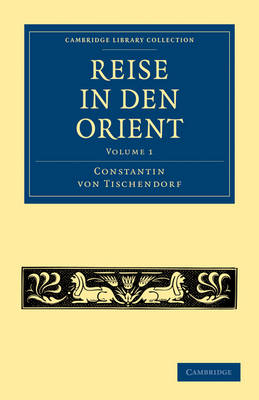Cambridge Library Collection - Travel, Middle East and Asia Minor
1 primary work • 5 total works
Volume 2
Reise in den Orient (1846) is the German biblical scholar Constantin von Tischendorf's recollection of his journey to Egypt, Israel and Greece at the beginning of the 1840s. The work is a travel diary that vividly describes Tischendorf's meeting with mythological places and impressive men, and a learned account of the Christian history of the area. Volume 1 describes his encounter with Ibrahim Pasha and the humanism of Mehmet Ali. Tischendorf undertakes research in the Library of the Patriarch of Alexandria and visits the pyramids, only to compare them with one of the great German cathedrals. At the Monastery of Saint Catherine on Mount Sinai, Tischendorf makes an extraordinary and significant discovery - a fourth-century manuscript, one of the main witnesses to the Septuagint. Thereafter he sets off for Jerusalem and en route takes delight in the fascinating and ancient traditions of the Bedouins, and their camels.
Reise in den Orient (1846) is the German biblical scholar Constantin von Tischendorf's recollection of his journey to Egypt, Israel and Greece at the beginning of the 1840s. The work is a travel diary that vividly describes Tischendorf's meeting with mythological places and impressive men, and a learned account of the Christian history of the area. Volume 1 describes, among many other encounters, his extraordinary and significant discovery - a fourth-century manuscript, one of the main witnesses to the Septuagint. Thereafter he sets off for Jerusalem, and Volume 2 largely focuses on his time in Israel, giving an historical account of Jerusalem as the centre of all religions. On his return journey, he is enraptured by Smyrna and Constantinople, and enjoys visiting the Athenian Acropolis and the other ruins of the ancient city.
This work, first published in 1847, is an account by Constantin von Tischendorf (1815–74) of his journeying in the Middle East at the beginning of the 1840s. It is part travel log and part account of the Christian history of the area. After encounters with such men as Mehmet Ali and Ibrahim Pasha, he visits the library of the Patriarch of Alexandria. The German biblical scholar then travels to the monastery of Saint Catherine on Mount Sinai, where he makes the extraordinary discovery of a previously unknown fourth-century manuscript, one of the main witnesses to the Septuagint, before reaching the main goal of his long journey - Jerusalem. This lively narrative by a controversial scholar-explorer also entertains the reader with some of the more unexpected elements of his travels, such as an attack by robbers who are routed when he draws his sword.
Reise in den Orient (1846) is the German biblical scholar Constantin von Tischendorf's recollection of his journey to Egypt, Israel and Greece at the beginning of the 1840s. The work is a travel diary that vividly describes Tischendorf's meeting with mythological places and impressive men, and a learned account of the Christian history of the area. Volume 2 of this work largely focuses on Tischendorf's time in Israel. He writes about Jesus' crucifixion and Golgotha's significance, and gives an historical account of Jerusalem as the centre of all religions. He pays particular attention to the Anglican Diocese of Jerusalem, which leads him to explain the differences between German and English Protestantism. On his return journey, he is enraptured by Smyrna and Constantinople, and enjoys visiting the Athenian Acropolis and the other ruins of the ancient city.
Reise in den Orient (1846) is the German biblical scholar Constantin von Tischendorf's recollection of his journey to Egypt, Israel and Greece at the beginning of the 1840s. The work is a travel diary that vividly describes Tischendorf's meeting with mythological places and impressive men, and a learned account of the Christian history of the area. Volume 1 describes his encounter with Ibrahim Pasha and the humanism of Mehmet Ali. Tischendorf undertakes research in the Library of the Patriarch of Alexandria and visits the pyramids, only to compare them with one of the great German cathedrals. At the Monastery of Saint Catherine on Mount Sinai, Tischendorf makes an extraordinary and significant discovery - a fourth-century manuscript, one of the main witnesses to the Septuagint. Thereafter he sets off for Jerusalem and en route takes delight in the fascinating and ancient traditions of the Bedouins, and their camels.



